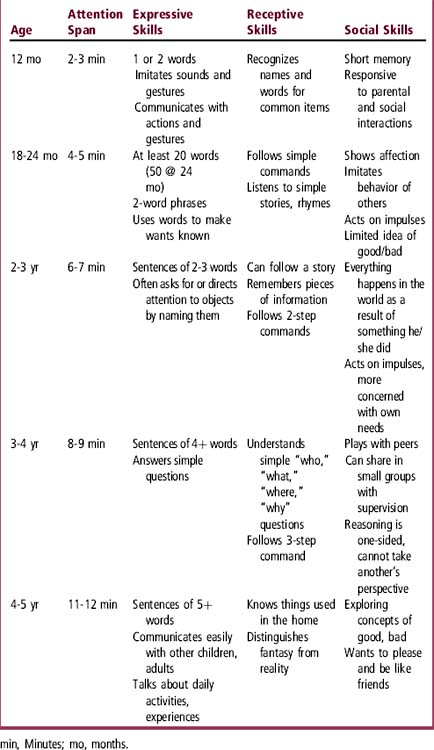Chapter 22 Behavior Problems
ETIOLOGY
How Common Are Behavior Problems?
Nearly 25% of school-age patients are evaluated by physicians for behavioral concerns ranging from minor temper tantrums to severe behaviors that cause injury to self or others. The behaviors may occur with one person or many, at home, in school, or anywhere. Severe, pervasive behavioral concerns are discussed in Chapter 55.
How Does Behavior Relate to Child Development?
Knowledge of development helps you understand a child’s behavior and identify an approach to take with the parent. Many concerns about behaviors reflect typical child development. For example, impulsivity and the inability to stay with an activity for more than a few minutes are age-appropriate for a 2-year-old but suggest the need for further evaluation of a 7-year-old. Table 22-1 lists developmental highlights that relate to behavior.
What about Genetic, Medical, and School Influences?
Genetic or medical factors may contribute to the problem behavior. These include the child’s temperament, a genetic disorder, chronic illness, and the child’s cognitive skills or learning style. For example, fragile X syndrome is associated with repetitive behaviors, perseveration, and hyperactivity. The teaching approach in the school may trigger and reinforce problem behavior if it does not match the child’s learning style. A child who learns best from visual cues may become frustrated with verbal explanations and act out in an attempt to escape demands. A child who has a learning disability may demonstrate “hyperactive” behaviors in school that only diminish after the learning disorder has been identified and an educational management program instituted (see Chapter 55).
EVALUATION
How Should I Begin an Evaluation of Behavior?
A good interview is important for gathering information.
 Be a good listener. Clarify and summarize parental concerns and key information.
Be a good listener. Clarify and summarize parental concerns and key information.
 Ask about the frequency and severity of the problem.
Ask about the frequency and severity of the problem.
 Determine if the behavior is appropriate for age and development.
Determine if the behavior is appropriate for age and development.
 Identify the initial trigger and what now reinforces the behavior.
Identify the initial trigger and what now reinforces the behavior.
 Be certain that you have enough information and understand the concern before offering suggestions.
Be certain that you have enough information and understand the concern before offering suggestions.
How Do I Determine What Reinforces a Behavior?
Table 22-2 provides examples of questions and some answers that suggest possible reinforcers.
Table 22-2 How To Identify Reinforcers of Behavior
| Questions | Possible Reinforcers |
|---|---|
| If the parent answers “yes” to question 1 or 2, the behavior could be reinforced by attention: The child has learned to gain attention by exhibiting problem behavior. | |
| If the parent answers “yes” to question 3 or 4, the behavior could be reinforced by the tangible item or preferred activity: The child has learned to gain the item or activity by exhibiting problem behavior. | |
| If the parent answers “yes” to question 5 or 6, the behavior could be reinforced by letting the child get out of undesired activities: The child has learned to escape undesired activities by exhibiting problem behavior. |
What Observations Will Help Me Assess Behavior?
Observe parent-child interactions in the clinic setting. Remember that interactions in clinic will not necessarily reflect what happens in other situations, but watch for general patterns. Observe the child’s response when you use one of the positive strategies in Table 22-3. If the child responds, try instructing the parent in these alternatives. If the child is unresponsive, and especially if similar behavior occurs in other situations, referral to a psychologist may be needed for further assessment and management.
Table 22-3 Parent-Child Interaction: Potential Problems and Positive Strategies
| Situation | Potential Problems | Positive Strategies |
|---|---|---|
| Child gets into dangerous situation (e.g.,climbing) | Parent ignores or uses strategies not appropriate for development (e.g., scolding or discussion with a 2-year-old child) | Parent intervenes early and uses strategies appropriate for development (e.g., redirection with a 2-year-old child) |
| Child is uncooperative with exam | Parent ignores or scolds | Parent attempts to help or suggests strategies successful in other situations |
| Child interrupts when parent is talking with you | Parent scolds | Parent redirects (a toddler) or states when it is the child’s turn to talk (a school-aged child) |
| Child plays well with toys or is cooperative with exam | Parent ignores | Parent provides intermittent, positive attention |
Stay updated, free articles. Join our Telegram channel

Full access? Get Clinical Tree










